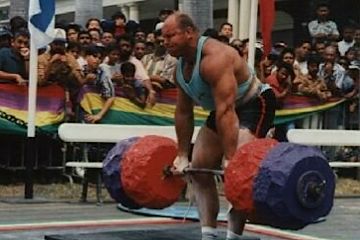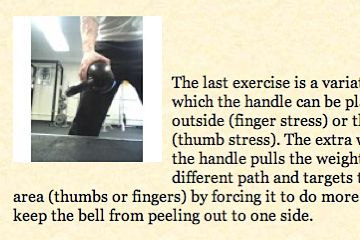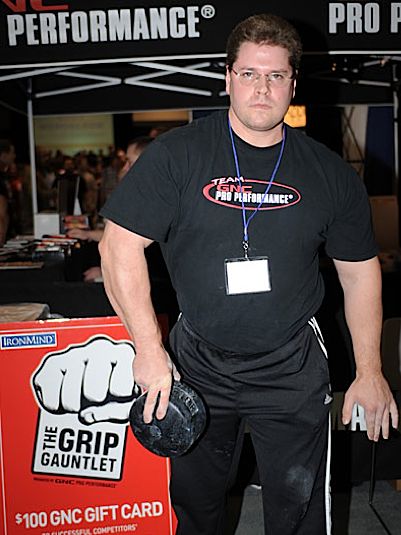Results matching “thumb”
 This is a guest post from bending and grip strength aficionado Adam T. Glass - Leverage lifts. Strap yourself in, this is a good one.
This is a guest post from bending and grip strength aficionado Adam T. Glass - Leverage lifts. Strap yourself in, this is a good one.
Webster defines Leverage as :
The mechanical advantage or power gained by using a lever
With these lifts, we will work backwards, and take away the advantage gained by using proper levers with a lift.
Look at this monstrous deadlift : perfect feet-knee-hip-back alignment. This lift is going up. If his hips were farther back, or the bar was off his body during the lift, he would have a significant disadvantage to this pull. He is applying proper leverage.
Most of your training should be done in the maximum advantage position. This is almost always the safest position to move the weight, and safe training equals productive training.
Most maximum strength or strength endurance events will require the athlete to achieve perfect leverage over the implement, or the effort will fail. This is clearly evident when you examine sports such as Powerlifting, Olympic lifting, the Kettlebell biathlon and arm wrestling. The problem is most events in life do not allow you to display maximum leverage because the external resistance is fighting you - football, wrestling, arm wrestling; or the size/shape of the object puts you in an awkward position - Strongman events, strength feats such as very short bends or odd objects such as horseshoes or wrenches.
To build power in these positions, you must learn to work with in them. Isometrics Cables, and odd objects such as kettlebells will fill in some gaps. To get an unusual level of strength, you must cross from the familiar to the strange: you must use unusual drills.
During my personal quest to increase my braced bending abilities I began to examine exactly how to generate the most leverage upon different objects. Learning to bend wrenches, tear cards with my arms over head, or pick up heavy clubs led to this conclusion - You have to train outside the 'Safe zone' or proper leverage and position. You have to make the movements awkward, and as you do you will find additional stability.
 Webster defines Leverage as :
Webster defines Leverage as :
The mechanical advantage or power gained by using a lever
With these lifts, we will work backwards, and take away the advantage gained by using proper levers with a lift.
Look at this monstrous deadlift : perfect feet-knee-hip-back alignment. This lift is going up. If his hips were farther back, or the bar was off his body during the lift, he would have a significant disadvantage to this pull. He is applying proper leverage.
Most of your training should be done in the maximum advantage position. This is almost always the safest position to move the weight, and safe training equals productive training.
Most maximum strength or strength endurance events will require the athlete to achieve perfect leverage over the implement, or the effort will fail. This is clearly evident when you examine sports such as Powerlifting, Olympic lifting, the Kettlebell biathlon and arm wrestling. The problem is most events in life do not allow you to display maximum leverage because the external resistance is fighting you - football, wrestling, arm wrestling; or the size/shape of the object puts you in an awkward position - Strongman events, strength feats such as very short bends or odd objects such as horseshoes or wrenches.
To build power in these positions, you must learn to work with in them. Isometrics Cables, and odd objects such as kettlebells will fill in some gaps. To get an unusual level of strength, you must cross from the familiar to the strange: you must use unusual drills.
During my personal quest to increase my braced bending abilities I began to examine exactly how to generate the most leverage upon different objects. Learning to bend wrenches, tear cards with my arms over head, or pick up heavy clubs led to this conclusion - You have to train outside the 'Safe zone' or proper leverage and position. You have to make the movements awkward, and as you do you will find additional stability.
 Steve Reishus looks at several ways to increase your grip work (including the thumb) with some simple kettlebell holds. If you've graduated to a heavy bell and are wondering what to do with the smaller one, this is perfect.
Steve Reishus looks at several ways to increase your grip work (including the thumb) with some simple kettlebell holds. If you've graduated to a heavy bell and are wondering what to do with the smaller one, this is perfect.
 Steve Reishus looks at several ways to increase your grip work (including the thumb) with some simple kettlebell holds. If you've graduated to a heavy bell and are wondering what to do with the smaller one, this is perfect.
Steve Reishus looks at several ways to increase your grip work (including the thumb) with some simple kettlebell holds. If you've graduated to a heavy bell and are wondering what to do with the smaller one, this is perfect.






